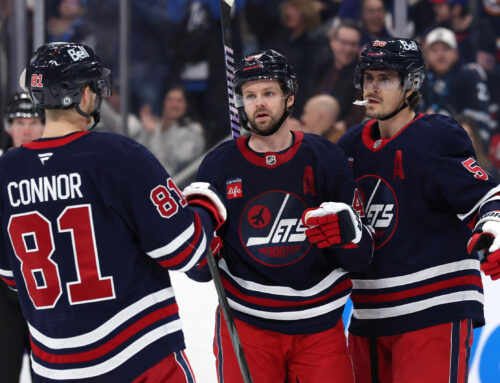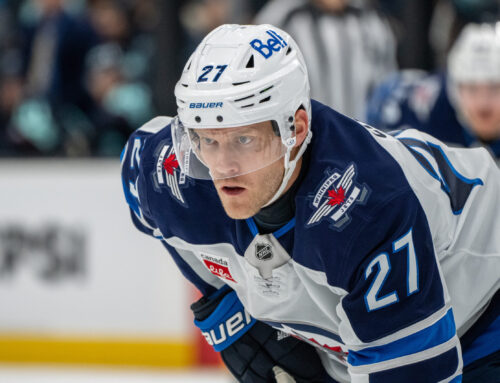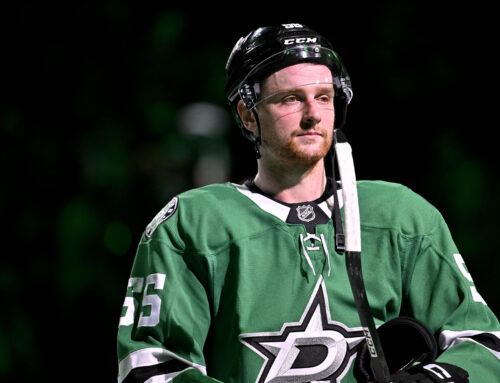
Can Devan Dubnyk and the Flames’ top line sustain their level of success from 2014-15?
Up this week are the feel good story of the year in the gritty, upstart, Calgary Flames and the turnaround of the year in the Minnesota Wild.
Minnesota
Statistically, aside from its goaltending, Minnesota was a better team before it got Devan Dubnyk than after the acquisition. The Wild remain an elite defensive team while upping their offensive game to over 30 shots per game. A lot of those shots came in the first half of the season as they averaged 2.5 shots more per 60 minutes played than they did in the second half. The reduced number of shots did not result in fewer goals largely because the Wild were scoring on close to 10% of their shots during the second half. With any improvement on the power play the Wild not only will be a top 10 team overall but a top 10 team offensively. Without improvement on the power play, they will be at the top of the middle offensively.
The acquisition of Dubnyk was the turning point of the Wild's season. Before his arrival the Wild were the third best team at generating shots and the fourth best at suppressing shots, yet due to having the league's worst goaltending they had the seventh worst goal differential at -16. After Dubnyk they did not shoot as much but remained an elite shot suppression team yet had the best goal differential at +45. The two halves balanced out to a save percentage just under Dubnyk's playoff save percentage which would put make them top 10 in goal differential. It is much more likely that Dubnyk plays like he did in these playoffs than how he played with the Wild this year or Oilers last year. On an elite shot suppression team like the Wild, Dubnyk will thrive. Bet on a save percentage in the neighbourhood of 92%, which will place him amongst the leaders in wins. Darcy Kuemper's disastrous start to the season resulted in him losing the starting job; however, from December on he was a league average goalie. There is reason to believe that this year was a blip for Kuemper. He will be the backup for a couple years but bet on him to rebound.
Zach Parise, Mikko Koivu, Jason Pominville and Tomas Vanek are the 30+ core up front for the Wild. Parise and Pominville are the two of the core who had successful years. Both take over three shots per game and have not shown any signs of slowing down. Parise was at the high end of his normal shooting percentage range, while Pominville suffered a drought falling below 8%, despite averaging 1.25 high danger scoring chances per game. Both will retain their value going forward.
Mikko Koivu is not getting it done from a production standpoint as he had his lowest P60 since the lockout. While still a useful player in real life, his fantasy value is entirely tied to him being on the top power play unit, which should end soon as his power play P60 was an abysmal 3.44. Thomas Vanek is no longer getting the opportunities he got in with the Sabres and the Islanders. This year he was down to 16 minutes per game, the least ice time he has received in five years. Vanek is taking fewer shots and not surprisingly scoring less per 60 minutes played despite still starting most of his shifts in the offensive zone. With limited minutes Vanek will not hit 60 points and may struggle to hit 50 if his power play minutes get cut.
Until Mikael Granlund gets more time on the power play, fantasy owners will have to wait for a breakout. Granlund needs to improve in two areas to push the Wild to get him more involved. The first is that he needs to shoot more as he played five more games than last year but took five fewer shots. He finished with only 99 shots in 68 games despite the Wild averaging over 35 shots per every 60 minutes he played. Grandlund's IPP slipped from 85 in his first two years to 58 this year. An IPP of 85% would get Granlund 58 points given his GF60 of 3.38, even a more reasonable 75% IPP would get Granlund 50 points.
With the Wild's 30+ forward core and Granlund firmly entrenched as a top six center the opportunities are limited for youngsters Charlie Coyle, Jason Zucker and Nino Niederreiter. Zucker received the most consistent time in the top six as he played 66% of his time with Mikko Koivu. Coyle and Niederreiter played a lot together but spent the most of their time on the third line. With none of the youngsters receiving two minutes per game on the power play the first to break through into the top six will have the best shot at 40+ points.
Ryan Suter is a minute eater playing in all situations who will never get to 50 points and any expectation should be capped at 45 points. Whether he gets 40 points next year will entirely depend on whether the Wild power play improves. With Suter's cap hit he will continue on the top power play unit unless a major dynamic option arises. Meanwhile Jared Spurgeon will remain second fiddle, as he consistently missing 15 games he will top out at 30 points. Matt Dumba, however, is the dynamic option that could steal minutes on the power play. He showed glimpses of this during the playoffs where he had the highest power play P60 amongst the Wild defensemen, albeit in limited minutes. Look for Dumba to start stealing power play minutes and even strength minutes, as he does 30 points next year is not out of the question.
UFA: Chris Stewart, Kyle Brodziak, Sean Bergenheim, Ryan Carter, Jordan Leopold, Keith Ballard, Devan Dubnyk
RFA: Mikael Granlund, Erik Haula, Christian Folin, Nate Prosser
Calgary
Only three teams made the playoffs having given up more shots than they took: the Flames, the Senators and the Habs. The Habs did it by relying on Carey Price, the Senators were just a high event team overall while the Flames did it by finishing seventh in goals while 28th in shots. The Flames accomplished this by scoring on 10% of their shots, an impressive but not a replicable feat. Since the 2008-09 season, three teams have scored on 10% or more of their shots in consecutive seasons, two of those occurrences included the 2012-13 lockout season. If the Flames regress to an average 9% shooting percentage, as they had last year, their production drops by half a goal per game. Unless the Flames take significantly more shots or get much better at shot suppression, they will plummet.
Jonas Hiller and Karri Ramo were a significant improvement in net for the Flames this year. The Flames went from having one of the worst save percentages in the league to running out a league average goalie at worst every night. Hiller was able to match his numbers from last year in Anaheim despite playing for a much worse defensive team. Despite playing only two more games this year he faced 26 more high danger shots and 2.4 more shots per 60 minutes played. Even though Hartley turned to Ramo in the second round, Hiller will get the bulk of the starts in Calgary while either Ramo or Ortio plays 20-30 games.
Gaudreau, Monahan and Hudler were a revelation as the Flames' top line. The lowest shooting percentage of three went to Gaudreau at 14.37%, while Hudler topped the trio at 19.62%. With shooting percentages like that it should be no surprise that they each had on-ice shooting percentages over 11%. While that likely will not last, they probably will not be asked to play nearly as tough minutes next year assuming all the Flames' centers do not get simultaneously injured again. Look for them to slide back closer to 55-60 points each.
Mikael Backlund drives possession, kills penalties and scores at a decent rate at 0.5 points per game. He has historically made those he plays with better. With very limited power play time Backlund will get 50 points at best and probably closer to 40. During the playoffs Sam Bennett received a lot of the Backlund treatment and scored at just under a 35-point pace as a result. That does not sound groundbreaking but he accomplished that while averaging under 14 minutes per game. Without getting first line minutes or top power play unit minutes Bennett will not challenge in the Calder, but a year playing alongside of Backlund would be very beneficial for him.
If Sam Bennett plays with Backlund next year that leaves one spot for either Joe Colborne or David Jones in the top six. Jones has the larger cap hit at $4 million, but Colborne makes more sense for the Flames' long term plans. The Flames had more success when Colborne played with Backlund than when Jones played did. The winner gets close to 40 points the loser will be lucky to get 25, bet on Colborne after his improvement this year.
Lance Bouma is the epitome of how this Flames offense worked. He doubled his rate of production by almost tripling his shooting percentage. The net result was 11 more goals than last year on 20 more shots. A better option is Micheal Ferland, as he brings the same peripherals while producing points at a higher rate than 2013-14 Bouma. Ferland should make a good value play at 20 points, 200+ hits, almost 100 penalty minutes and half as many blocks.
Mark Giordano and TJ Brodie are the bona fide top pair for the Flames. Brodie should be judged by his numbers before the Giordano injury, as Giordano was on pace for just over 60 points while Brodie was on pace for just over 40 points. For your benefit disregard the time he was anchored to Deryk Engelland. While their on-ice shooting percentages were a little high, both around 11%, their respective paces are entirely reasonable. Dennis Wideman is a different case, as he scored on just under 10% of his shots, 2.5 points above his previous career high. He had eight of his 13 power play points after Giordano's injury. Combine those factors and Wideman is in for a big drop.
UFA: David Schlemko, Raphael Diaz, Corey Potter, Karri Ramo
RFA: Mikael Backlund, Josh Jooris, Drew Shore, Lance Bouma, Micheal Ferland, Paul Byron
2015 Offseason Fantasy Look: Nashville and St. Louis





 S.J
S.J EDM
EDM ANA
ANA BUF
BUF PIT
PIT
 MIN
MIN DET
DET CBJ
CBJ UTA
UTA
